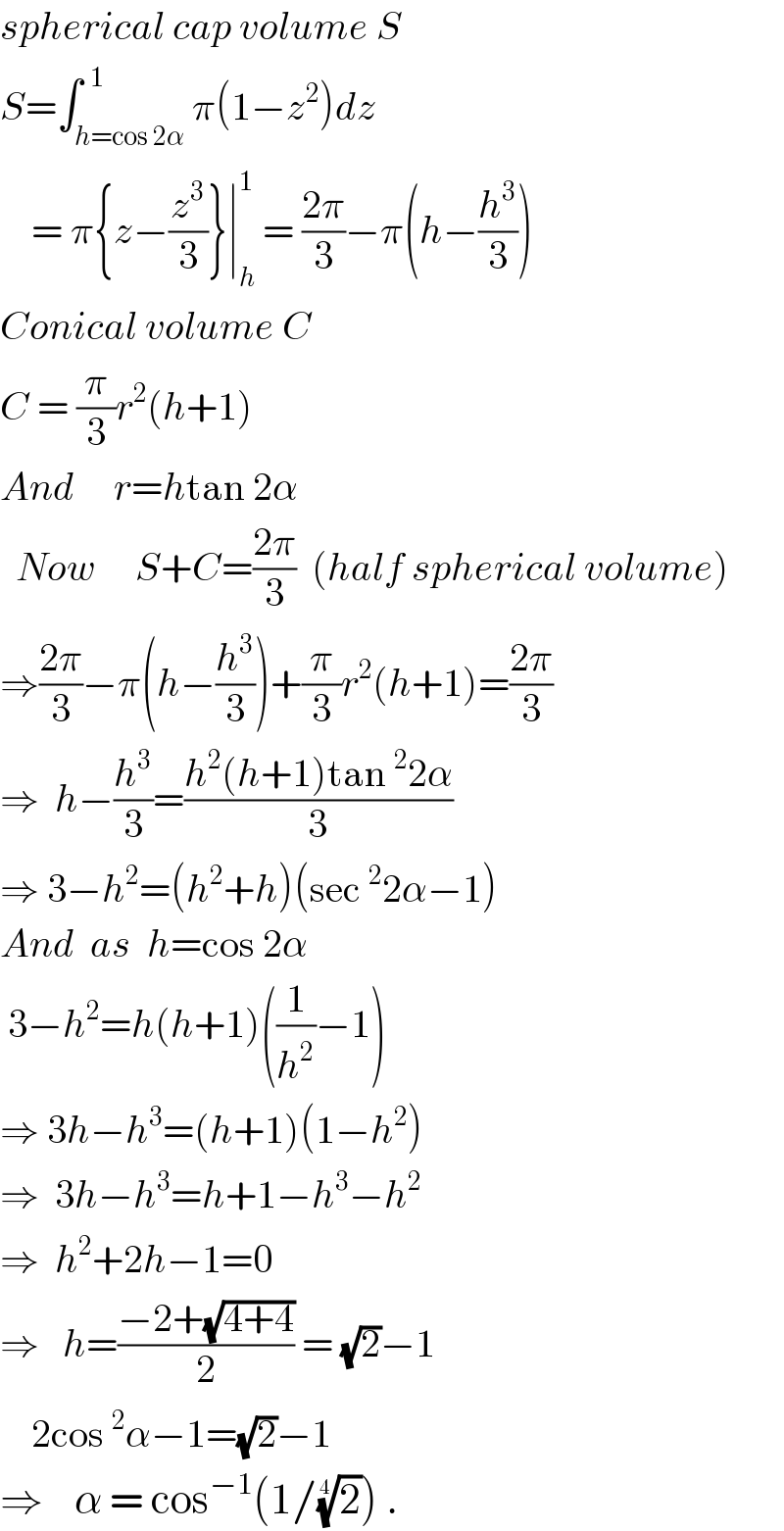
Question Number 62821 by ajfour last updated on 25/Jun/19

Commented by ajfour last updated on 25/Jun/19

$${If}\:{the}\:{right}\:{circular}\:{cone}\:{contains} \\ $$$${half}\:{the}\:{spherical}\:{volume}\:{within} \\ $$$${its}\:{lateral}\:{surface},\:{find}\:\boldsymbol{\alpha}. \\ $$
Answered by ajfour last updated on 25/Jun/19

Commented by ajfour last updated on 25/Jun/19

$${spherical}\:{cap}\:{volume}\:{S} \\ $$$${S}=\int_{{h}=\mathrm{cos}\:\mathrm{2}\alpha} ^{\:\:\mathrm{1}} \pi\left(\mathrm{1}−{z}^{\mathrm{2}} \right){dz} \\ $$$$\:\:\:\:=\:\pi\left\{{z}−\frac{{z}^{\mathrm{3}} }{\mathrm{3}}\right\}\mid_{{h}} ^{\mathrm{1}} \:=\:\frac{\mathrm{2}\pi}{\mathrm{3}}−\pi\left({h}−\frac{{h}^{\mathrm{3}} }{\mathrm{3}}\right) \\ $$$${Conical}\:{volume}\:{C} \\ $$$${C}\:=\:\frac{\pi}{\mathrm{3}}{r}^{\mathrm{2}} \left({h}+\mathrm{1}\right) \\ $$$${And}\:\:\:\:\:{r}={h}\mathrm{tan}\:\mathrm{2}\alpha \\ $$$$\:\:{Now}\:\:\:\:\:{S}+{C}=\frac{\mathrm{2}\pi}{\mathrm{3}}\:\:\left({half}\:{spherical}\:{volume}\right) \\ $$$$\Rightarrow\frac{\mathrm{2}\pi}{\mathrm{3}}−\pi\left({h}−\frac{{h}^{\mathrm{3}} }{\mathrm{3}}\right)+\frac{\pi}{\mathrm{3}}{r}^{\mathrm{2}} \left({h}+\mathrm{1}\right)=\frac{\mathrm{2}\pi}{\mathrm{3}} \\ $$$$\Rightarrow\:\:{h}−\frac{{h}^{\mathrm{3}} }{\mathrm{3}}=\frac{{h}^{\mathrm{2}} \left({h}+\mathrm{1}\right)\mathrm{tan}\:^{\mathrm{2}} \mathrm{2}\alpha}{\mathrm{3}} \\ $$$$\Rightarrow\:\mathrm{3}−{h}^{\mathrm{2}} =\left({h}^{\mathrm{2}} +{h}\right)\left(\mathrm{sec}\:^{\mathrm{2}} \mathrm{2}\alpha−\mathrm{1}\right) \\ $$$${And}\:\:{as}\:\:{h}=\mathrm{cos}\:\mathrm{2}\alpha \\ $$$$\:\mathrm{3}−{h}^{\mathrm{2}} ={h}\left({h}+\mathrm{1}\right)\left(\frac{\mathrm{1}}{{h}^{\mathrm{2}} }−\mathrm{1}\right) \\ $$$$\Rightarrow\:\mathrm{3}{h}−{h}^{\mathrm{3}} =\left({h}+\mathrm{1}\right)\left(\mathrm{1}−{h}^{\mathrm{2}} \right) \\ $$$$\Rightarrow\:\:\mathrm{3}{h}−{h}^{\mathrm{3}} ={h}+\mathrm{1}−{h}^{\mathrm{3}} −{h}^{\mathrm{2}} \\ $$$$\Rightarrow\:\:{h}^{\mathrm{2}} +\mathrm{2}{h}−\mathrm{1}=\mathrm{0} \\ $$$$\Rightarrow\:\:\:{h}=\frac{−\mathrm{2}+\sqrt{\mathrm{4}+\mathrm{4}}}{\mathrm{2}}\:=\:\sqrt{\mathrm{2}}−\mathrm{1} \\ $$$$\:\:\:\:\mathrm{2cos}\:^{\mathrm{2}} \alpha−\mathrm{1}=\sqrt{\mathrm{2}}−\mathrm{1} \\ $$$$\Rightarrow\:\:\:\:\alpha\:=\:\mathrm{cos}^{−\mathrm{1}} \left(\mathrm{1}/\sqrt[{\mathrm{4}}]{\mathrm{2}}\right)\:. \\ $$
Answered by mr W last updated on 25/Jun/19

$${R}={radius}\:{of}\:{sphere} \\ $$$${k}={height}\:{of}\:{cone} \\ $$$${h}={height}\:{of}\:{cap}=\mathrm{2}{R}−{k} \\ $$$${r}={radius}\:{of}\:{section}\:{circle}\:{cone}\:/\:{sphere} \\ $$$$\frac{{r}}{{k}}=\frac{\mathrm{2}{R}−{k}}{{r}} \\ $$$$\Rightarrow{r}^{\mathrm{2}} ={k}\left(\mathrm{2}{R}−{k}\right) \\ $$$${volume}\:{of}\:{cone}=\frac{\pi{r}^{\mathrm{2}} {k}}{\mathrm{3}}=\frac{\pi{k}^{\mathrm{2}} \left(\mathrm{2}{R}−{k}\right)}{\mathrm{3}} \\ $$$${volume}\:{of}\:{cap}=\frac{\pi{h}^{\mathrm{2}} \left(\mathrm{3}{R}−{h}\right)}{\mathrm{3}}=\frac{\pi\left(\mathrm{2}{R}−{k}\right)^{\mathrm{2}} \left({R}+{k}\right)}{\mathrm{3}} \\ $$$${volume}\:{of}\:{sphere}=\frac{\mathrm{4}\pi{R}^{\mathrm{3}} }{\mathrm{3}} \\ $$$$\frac{\pi{k}^{\mathrm{2}} \left(\mathrm{2}{R}−{k}\right)}{\mathrm{3}}+\frac{\pi\left(\mathrm{2}{R}−{k}\right)^{\mathrm{2}} \left({R}+{k}\right)}{\mathrm{3}}=\frac{\mathrm{1}}{\mathrm{2}}×\frac{\mathrm{4}\pi{R}^{\mathrm{3}} }{\mathrm{3}} \\ $$$$\left(\mathrm{2}{R}−{k}\right)\left(\mathrm{2}{R}+{k}\right)=\mathrm{2}{R}^{\mathrm{2}} \\ $$$$\mathrm{4}{R}^{\mathrm{2}} −{k}^{\mathrm{2}} =\mathrm{2}{R}^{\mathrm{2}} \\ $$$$\Rightarrow{k}=\sqrt{\mathrm{2}}{R} \\ $$$${k}=\mathrm{2}{R}\:\mathrm{cos}^{\mathrm{2}} \:\alpha=\sqrt{\mathrm{2}}{R} \\ $$$$\Rightarrow\mathrm{cos}^{\mathrm{2}} \:\alpha=\frac{\mathrm{1}}{\sqrt{\mathrm{2}}} \\ $$$$\Rightarrow\alpha=\mathrm{cos}^{−\mathrm{1}} \frac{\mathrm{1}}{\sqrt[{\mathrm{4}}]{\mathrm{2}}} \\ $$
Commented by ajfour last updated on 25/Jun/19

$${Thanks}\:{for}\:{the}\:{solution},\:{Sir}. \\ $$
